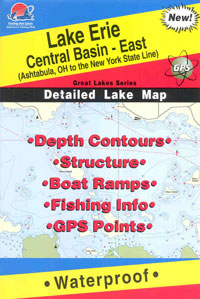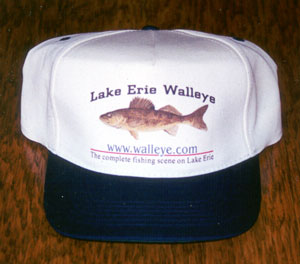|
Falls
Trophy Walleyes
by Keith Kavajecz & Gary Parsons
So you know how to catch enough small walleyes, but what about
catching those big ones? Eights, nines or even double digit walleyes
are out there and we're going to tell you how we catch a lot of the
big fish you see us holding up in photos! If you're looking for a
trophy, this fall offers tremendous opportunity. For starters,
you'll have to know is where to look for big walleyes.
September is the beginning of the fall trophy bonanza. Targeting
the biggest fish in a system calls for searching specific locations
and figuring out what techniques will work best. Let's look at big
 natural
lakes, reservoirs and areas around the Great Lakes, first in general
terms, then point out some particularly good waters. natural
lakes, reservoirs and areas around the Great Lakes, first in general
terms, then point out some particularly good waters.
Generally speaking, in September look for big walleyes in the
area leading to mouths of the rivers. We're not talking about the
river proper, but out in the lake or reservoir, perhaps in the area
within six miles of the river mouth. We're talking about walleyes
that are staging somewhere in their migration that will eventually
lead many of them up the river for a false spawn or later into the
river to prepare for their early spring spawn. This holds true
almost anywhere rivers provide spawning habitat and dump into a
larger body of water.
Somewhere within this area of the lake that's influenced by the
river are smaller areas in which the fish are eating, and you need
to find them. In the fall, walleyes start going on a baitfish binge.
As fall goes into full swing, the big females eat everything they
can sink their teeth into, putting egg development into high gear.
Sometimes this feeding area will be a reef that the walleyes move
up onto at night, perhaps feasting on spawning ciscoes. Or it could
be shallow, weedy areas, also foraged at night. Other times,
especially in reservoirs, they suspend out from points, moving in
throughout the day and night to feed. In Great Lakes walleye
fisheries, the walleyes often hang the basins of deep bays,
attacking clouds of bait that are so big they look like humps on the
fish finder.
Let's take them one at a time:
Shallow Reefs
These are areas found on most Great Lakes and large natural
lakes. Find reefs topping out at 10 to three feet. Cast crankbaits
or jigs at them during the day or--often better--light the top with
a buoy and troll the reef at night. Use floating baits like a
shallow ThunderStick, and add a split shot or two, if necessary, to
keep the bait near bottom. Troll around the top and the edge. A
small "kicker" engine will normally work great since you'll be long
lining the bait. If stealth seems necessary, use the electric. A
Minn Kota Auto-Pilot is especially easy to use for this.
Weedbeds
Find the greenest weeds you can. During the day, a jigging spoon
fluttered over the top and dropped down the weedline can be killer.
Or wait until dark and twitch Shallow ThunderSticks over the top.
Anchoring right in the middle of the weeds and casting to open water
beyond the edges with a Storm Rattlin' ThinFin can also produce
awesome results. Walleyes often seem programmed to attack bait as it
comes from open water and into the weeds.
Reservoir Points
You'll sometimes see the schools, suspended, say 18 feet down.
That's when you select a crank that will go that deep, like a Deep
ThunderStick, and troll the structure at the 18- foot level. If they
don't respond to that, you might have to switch to a more subtle
crankbait like a shallow ThunderStick Jr. and use Snap Weights to
get it to the fish level. Keep the colors simple. Black or blue
backs with a white belly are hard to beat!

Big live bait is a second choice. For presentations like jigs and
minnows or bottom bouncers and spinners, use minnows at least three
inches on up to six inches long. Redtail chubs or shiners are a good
bet. Or opt for the big crawlers - ones that look like minature
snakes. Big walleyes often prefer a big bait at this time of year.
Early morning and late afternoon are often the best times to try
these areas. We like to use Mustad's Finesse hooks when using live
bait. The hooks are light wire, but are manufactured using Aus
Tempering - which keeps them strong even though they're so thin. Use
#2 hooks for minnows, #4 or #6 two hook harnesses for crawlers.
Basins
When walleyes are belly to the bottom in Great Lakes basins,
target them with crankbaits put right in their faces. Try higher
action baits like Hot-N-Tots and Deep ThunderSticks first and get
progressively more subtle with Deep Jr. ThunderSticks, regular-size
shallow ThunderSticks and ThunderStick Jrs.
For all of the trolling applications mentioned, make sure to take
a look at using Berkley's FireLine. It has several advantages for
pulling crankbaits. First, since it is no- stretch you will be able
to monitor the lures action - even though it might be several
hundred feet behind the boat. Second it is thin diameter, so you can
get 30 to 40% more depth from the diving crankbaits. Finally, for
the trophies you're after you won't find a stronger line. Two years
ago, Keith caught his largest walleye ever (15.8 pounds) on 6-2
FireLine (6 pound test, 2 pound diameter). For trolling use the 10-4
FireLine. If there is any problems with breaking off fish then we
need to talk about how to fight big fish, not how catch big
walleyes.
To really increase your odds of big fish contact, concentrate on
big fish waters. Here's a list: The Winnipeg River system in Canada
near Pine City. Lake Tobin in Nipawin Saskatchewan. Missouri River
system, both the mouth of the Cheyenne in Lake Oahe, South Dakota
and at Oahe's headwaters near the North Dakota/South Dakota state
line; the Red River system in Manitoba.
Lake Michigan areas for big fish include Sturgeon Bay, Wisconsin,
and Little Bay de Noc, Michigan. Lake Huron's Saginaw Bay can be
incredible near river mouths. The St. Louis River area of Lake
Superior on the Wisconsin/Minnesota line and the deeper reefs of
Lake Ontario near the Thousand Island area of New York or on Lake of
the Woods in northern Minnesota. And, of course, there are dozens of
areas in Lake Erie that fill the bill. And if you want a superb
fishing vacation, try the night bite on Lake Winnibigoshish out of
Judd's Resort in Minnesota.
It really doesn't take a lot more skill to catch big walleyes
than it does small ones. It's really just a matter of finding them
and putting a big fish presentation in front of their faces. By
targeting the above locations and bodies of water, your chances for
a landing a trophy walleye will be improve dramatically. |





 natural
lakes, reservoirs and areas around the Great Lakes, first in general
terms, then point out some particularly good waters.
natural
lakes, reservoirs and areas around the Great Lakes, first in general
terms, then point out some particularly good waters.